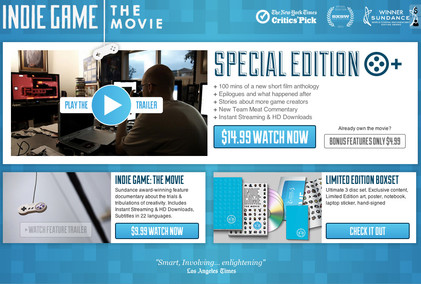
A site for monetising and distributing video has launched out of public beta, allowing anyone to put a price on access to their video content for free.
VHX, which launched in private beta in 2012, allows users to host individual videos or bundles of content on a customisable site or embedded on an existing page.
"It makes sense to have free content available which you can put on YouTube or on your own site, and that's something we support natively," Jamie Wilkinson, founder and chief executive of VHX, told Journalism.co.uk, "but it also makes sense to have more premium content like micro-documentaries or long-form investigative journalism."
Users can set a specific fee or use a "pay-what-you-want model", said Wilkinson, with VHX taking a ten per cent cut and $0.50 processing fee from each transaction, before videos are embedded or distributed from a customisable domain.
"The analogy we often use is that it's like Tumblr for premium video," he said, "in that we have a very advanced theming engine and a theme garden. If you don't have a website you can sign up, pick a theme, customise it, upload your art and start publishing. Just upload your videos and set a price."

Screenshot from IndieGameTheMovie.com, the website for a film of the same name which uses a "highly customised" site theme from VHX
Alongside the possibilities for original content, Wilkinson said he had been in conversation with news organisations about curating videos from elsewhere around VHX and bundling different types of video together.
"The pitch we always use is that it's like a roll your own iTunes or Netflix," he said. "iTunes is a platform filled with other people's content – none of that is created by Apple – and the majority of content on Netflix is not created by Netflix. That's the direction we see things moving in."
Wilkinson first launched VHX in private beta in 2012, spending the last two years "working with creators to understand how challenging [self-distribution] can be and building the software that can help solve all that".
Online video is a growing medium for news organisations, both those with a legacy in print and digital first.
Last year Denise Warren, executive vice-president of the New York Times's digital products and services group, said the Times was looking to "push video as a core area" as all online video was placed outside the NYTimes.com paywall; and Alan Rusbridger promised to "radically develop" the Guardian's "video journalism and multimedia offering" alongside last week's editorial reshuffle.
Streaming video supported by advertising is the current model used by the majority of news organisations, but Wilkinson said other options may be better suited to both the publisher and viewer.
"Right now we require both [streaming and downloading] as it offers a better experience for customers," he said.
"Our goal is to make things as widely available as possible worldwide as well as making them available on as many devices as possible."
Free daily newsletter
If you like our news and feature articles, you can sign up to receive our free daily (Mon-Fri) email newsletter (mobile friendly).
Related articles
- Audiences, AI and audio apps: five talking points from Perugia
- 200 speakers you need at your next journalism event to avoid all-male panels
- Five key takeaways from the UK select committee on the future of news
- From Reuters to The New York Times, Big Oil pays 'most trusted media brands' to push greenwashing
- Standing out in a crowded market: what makes a top news podcast?









